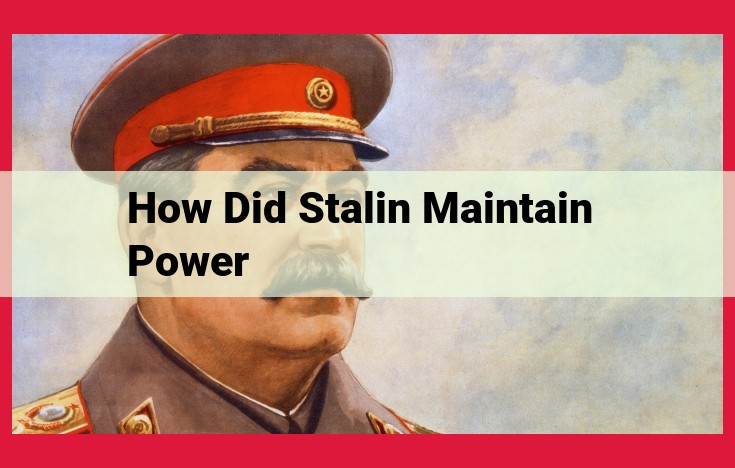Stalin’s maintenance of power involved extensive political control through secret police repression, propaganda, and suppression of dissent. He implemented economic policies like Five-Year Plans and forced collectivization, exploiting workers and suppressing economic freedom. The centralized Communist Party and Marxist-Leninist ideology enforced political conformity, and military expansion solidified his authority. Key individuals like Beria, Molotov, and Khrushchev played significant roles in Stalin’s regime, with Beria’s role in the Great Purge being particularly notable.
Political Repression and Control under Stalinism
Stalin’s grip on the Soviet Union was enforced through a systematic and ruthless suppression of dissent. The NKVD, the secret police, became an instrument of terror, conducting purges that eliminated any perceived threats to Stalin’s authority. The Gulag Archipelago, a vast network of forced labor camps, symbolized the mass suffering and political repression of the era.
Show trials were staged to publicly humiliate and eliminate political rivals and opponents. These spectacles served to instill fear in the population and reinforce the image of Stalin as an infallible and heroic leader. Propaganda played a vital role in controlling the narrative, portraying Stalin as a benevolent father figure while suppressing alternative viewpoints.
The media was strictly censored, suffocating free speech and dissenting opinions. Journalists, writers, and artists faced persecution and imprisonment for expressing views that deviated from the official party line. The aim was to create a monolithic society that unquestioningly adhered to the cult of personality surrounding Stalin. This reign of political repression and control permeated every aspect of Soviet life, leaving a lasting legacy of fear, silencing, and suppression.
Economic Impact of Stalinism: A Story of Coercion and Suffering
Government-Directed Economic Revolution:
Stalin’s economic policies were driven by the centralized planning and rapid industrialization of the Five-Year Plans. These programs prioritized state control over the economy and emphasized growth at the expense of individual liberty. The government seized private businesses and resources, eliminating economic freedom.
Forced Collectivization: A Disaster for Agriculture
One of the most devastating aspects of Stalinism was the forced collectivization of agriculture. Farmers were coerced into joining collective farms, where they lost their land and livestock. This ruthless policy led to widespread famine and starvation, resulting in millions of deaths.
Stakhanovite Movement: Exploitation in the Name of Productivity
To increase industrial production, Stalin introduced the Stakhanovite Movement. This incentive program rewarded workers who exceeded exorbitant production quotas. However, this exploitative system pushed workers to their physical limits, leading to exhaustion and injuries. It also created a culture of fear and competition, as workers were constantly under pressure to meet unrealistic targets.
Ideological and Political Structures Under Stalin’s Regime: Shaping a Totalitarian Society
The Communist Party of the Soviet Union (CPSU): A Monolithic Power Base
At the heart of Stalin’s regime lay the Communist Party of the Soviet Union (CPSU), a monolithic ruling party under his absolute control. The party served as the primary instrument of political power, permeating every aspect of Soviet society and ensuring Stalin’s unchallenged authority.
Marxism-Leninism: The Supremacy of Ideology
The official state ideology, Marxism-Leninism, was skillfully employed as a tool of control. It suppressed religious and alternative political beliefs, portraying Stalin as the true inheritor of Lenin’s revolutionary legacy. By suppressing dissent and promoting ideological conformity, Stalin effectively suffocated any challenges to his rule.
Stalin’s Suppression of Nationalism: Consolidation of Power
To further consolidate his power, Stalin suppressed nationalist movements within the vast expanse of the Soviet Union. He ruthlessly crushed any expressions of cultural diversity or aspirations for independence, ensuring a homogenous society subservient to his regime.
The Soviet Military Under Stalin’s Reign
Expansion and Industrialization
Under Stalin’s ironclad rule, the Red Army underwent a meteoric expansion and unprecedented industrialization. Driven by the paranoia of potential threats, Stalin poured immense resources into building a military force that would dominate the Eastern bloc and strike fear into its adversaries. Factories churned out tanks, aircraft, and weaponry at an astonishing pace, transforming the Soviet Union into a formidable military power.
Purge of Red Army Generals
However, beneath this facade of military might lay a sinister plot. In the notorious years of 1937-1938, Stalin orchestrated a brutal purge that decimated the ranks of the Red Army’s generals. Fearful of any potential dissent or rivalry to his authority, he ordered the executions or imprisonments of countless military leaders, including some of the Soviet Union’s most brilliant and experienced commanders. This heinous act not only weakened the military’s strategic capabilities but also instilled a climate of terror and distrust.
Key Individuals in the Stalinist Era
Joseph Stalin’s iron-fisted rule over the Soviet Union was shaped and enforced by a cadre of loyal and ruthless individuals. Among them, Lavrenty Beria, Vyacheslav Molotov, and Nikita Khrushchev played pivotal roles in shaping the horrors of Stalinism.
Lavrenty Beria: The Architect of Terror
As the head of the NKVD (secret police), Beria became the embodiment of Stalin’s reign of terror. He orchestrated the Great Purge, a systematic campaign of arrests, torture, and executions that eliminated millions of perceived threats to Stalin’s power. The Gulag Archipelago, a vast network of forced labor camps, was Beria’s creation, symbolizing the horrors of Stalin’s repressive apparatus.
Vyacheslav Molotov: Stalin’s Loyal Foreign Minister
Molotov served as Stalin’s long-serving foreign policy leader, becoming notorious for his role in the Molotov-Ribbentrop Pact with Nazi Germany. Despite witnessing the horrors of Stalin’s rule, Molotov remained a staunch loyalist, unwavering in his dedication to the dictator. His unwavering loyalty earned him a place as one of Stalin’s most trusted confidants.
Nikita Khrushchev: Stalin’s Successor and Denouncer
Khrushchev initially rose under Stalin’s patronage, becoming a key figure in the Communist Party. However, after Stalin’s death, Khrushchev emerged as a vocal critic of his predecessor’s policies. In the famous “Secret Speech” of 1956, he denounced Stalin’s “cult of personality” and exposed the horrors of Stalinism. Khrushchev’s denunciation marked a watershed moment in Soviet history, paving the way for the gradual process of de-Stalinization.




